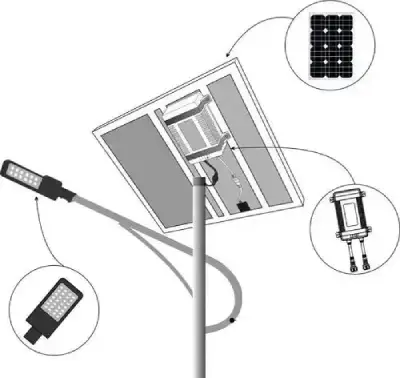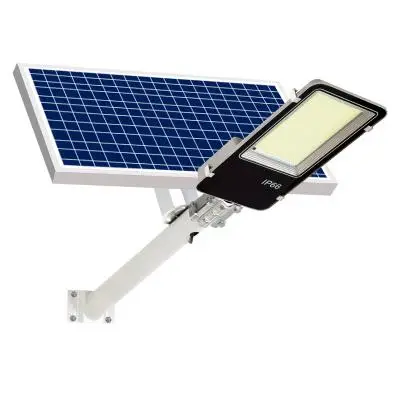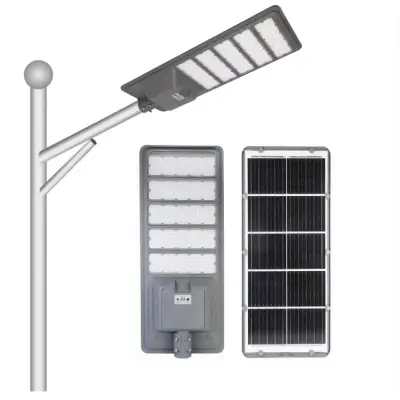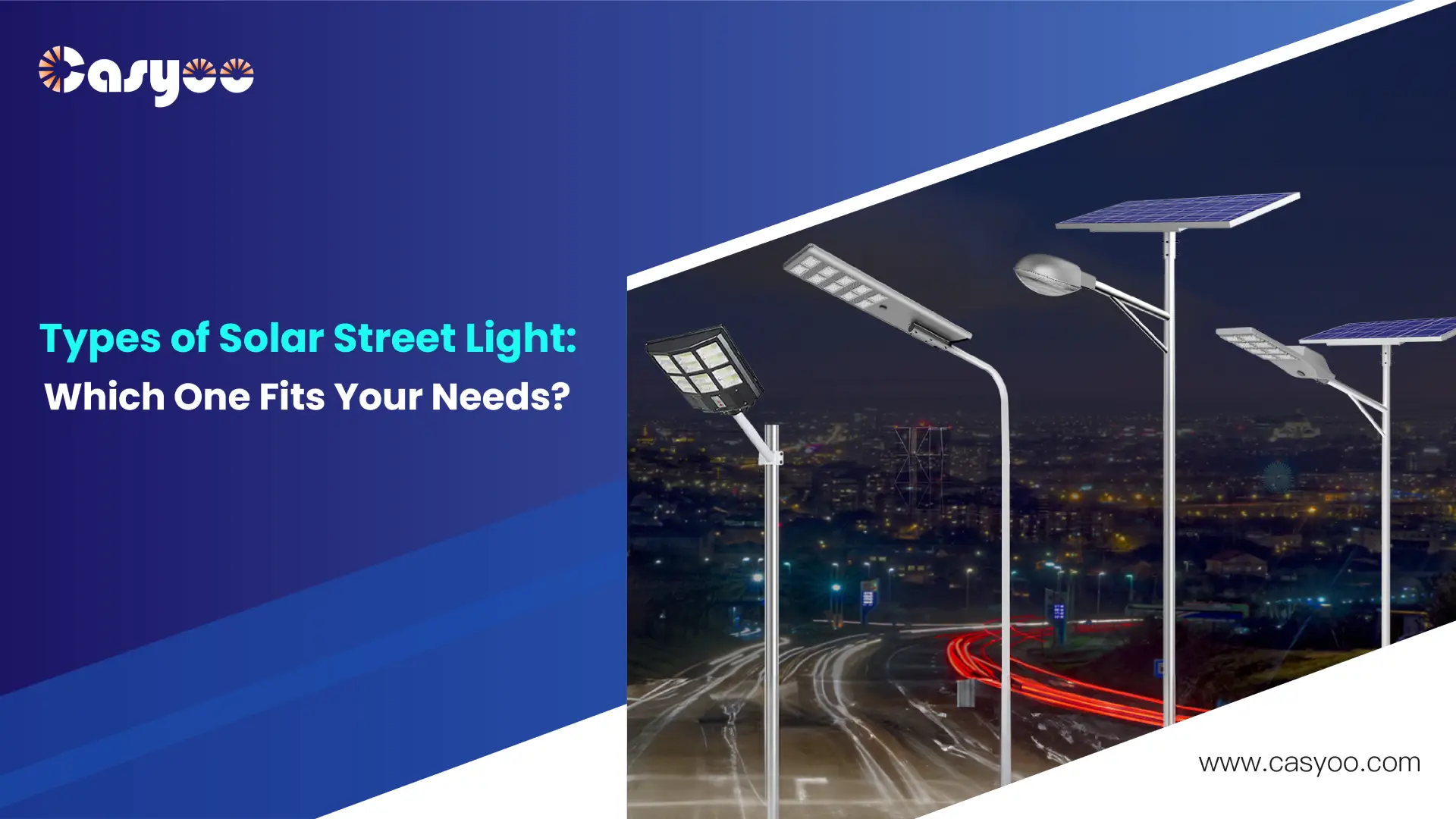With the worldwide street lighting system undergoing major transformations, choosing the proper sort of solar street light is more important than ever. According to the most recent industry report, the world’s 315 million streetlights will increase to 359 million by 2026. With vast expertise in LED technology, this evolution has become clear, and common queries from project stakeholders frequently focus on three main areas: How many different varieties are available? What distinguishes integrated and split types? And which type is most efficient?
These are more than just technical questions; they are basic concerns that have a considerable impact on project success, long-term viability, and return on investment.
The Evolution of Solar Street Light Technology
Consider the growth of solar street lights to be similar to that of mobile phones, from cumbersome discrete components to sleek, integrated gadgets. First-generation split-type lights, with their separate panels and batteries, resembled early mobile phones with external antennae. Like flip phones, the second-generation all-in-two devices moved components closer together. Today’s all-in-one solutions exemplify the smartphone era: tiny, efficient, and intelligent.
This evolution is not solely about aesthetics. Each each generation has resulted in considerable advances in efficiency, installation convenience, and maintenance requirements. The most recent advances include AI-powered adaptive lighting and IoT integration, which are pushing the frontiers of what is achievable in public lighting.
Split Solar Street Lights: The Classic Workhorse
Split solar street lights, the first generation of solar lighting solutions, feature separate components for maximum versatility. Consider it a modular kitchen, where you can place each equipment exactly where you need it.
Mounted on top of the pole, the solar panel is oriented to capture the most sunlight possible. The battery unit is often mounted lower on the pole or occasionally buried underground, while the LED fixture is positioned to provide maximum illumination.
Key Technical Specifications:
- Solar Panel: 80W-200W monocrystalline panels
- Battery: 12V/24V, typically lead-acid or gel
- Mounting Height: 6-12 meters
Pros:
- Highly customizable component placement
- Easier battery access for maintenance
- Flexible solar panel positioning for maximum exposure
- Individual component replacement possible
Cons:
- More complex installation process
- Higher initial setup costs
- Greater risk of theft for exposed components
- More wiring connections required
Best suited for: Large-scale installations where maintenance accessibility and customisation are essential.

Semi-integrated (All-in-Two) Solar Street Lights: The Balanced Solution
The technology for solar street lighting has advanced significantly with the introduction of the second generation all-in-two systems. These methods keep the solar panel independent while combining the battery and light fixture into one unit.
This type has proven efficient in projects with varying sunshine circumstances. The independent panel installation enabled us to maximize solar capture while keeping a clean appearance with the integrated light-battery combination.
Technical Highlights:
- Integrated LED-battery unit
- Adjustable solar panel positioning
- Lithium battery options (typically 12V/24V)
- Smart control capabilities
The efficiency advantages are significant; actual studies have shown increased energy efficiency due to reduced wire losses and higher thermal performance.

Fully Integrated (All-in-One) Solar Street Lights: The Modern Solution
All-in-one systems reflect the most recent advancement in solar street lighting. As someone who has seen this technology evolve from its inception to widespread adoption, I can witness to its transformative impact on the industry.
These systems combine all components – solar panel, battery, LED light, and controller – into a single, streamlined unit. For urban installations where aesthetics are just as significant as usefulness, they are growing in popularity.
Core Specifications:
- Battery Life: 5-7 years (lithium phosphate)
- Smart Controls: Motion sensing and remote monitoring
- Installation Height: 4-8 meters
The key innovation here is the integrated design’s effect on installation costs. Installation timeframes for urban projects are greatly decreased when compared to classic split systems.

Key Technical Specifications Across Types
Making wise selections requires an understanding of technological specifications. Let’s look down the key parameters that characterize each category:
Power Requirements
The primary differences among solar street lights are their power supply techniques and system requirements.
Split solar street lights provide the most flexible power options. They can run in three modes: entirely off-grid utilizing only solar power, grid-tied with solar as a supplement, or hybrid mode, which combines both sources. These systems typically operate on 24V/48V and require skilled electrical installation with dedicated wiring boxes and connection connections.
All-in-Two Solar Street Lights primarily function as standalone units, although they can be outfitted with backup power connectors. They operate on 12V/24V systems and have simplified wiring, which primarily connects the solar panel to the integrated light-battery. This makes them ideal for places with consistent solar resources but occasional needs for backup power.
All-in-One Solar Street Lights have the simplest power setup. These entirely autonomous systems run on 12V and require no extra wiring or power connections. This plug-and-play method makes maintenance and installation easier.
Battery Technology Comparison
Lithium vs lead acid is frequently a critical decision point. While lithium batteries initially cost 3-4 times more, their extended lifespan and superior performance frequently justify the expenditure. Here is what the data reveals:
Lithium Batteries:
- Lifespan: 7-10 years
- Depth of discharge: Up to 80%
- Temperature tolerance: -20°C to 60°C
- Weight: 1/3 of lead-acid equivalent
Lead-acid Batteries:
- Lifespan: 3-5 years
- Depth of discharge: Up to 50%
- Temperature tolerance: -10°C to 50°C
- Lower initial cost but higher maintenance needs
Control System Response Time
The reaction time of lighting control systems varies greatly between different types of solar street lights, affecting their real-world performance and energy efficiency. Split systems often have 1-2 second response times due to their scattered component architecture and lengthier signal transmission pathways. Semi-integrated systems outperform with 0.5-1 second response times, while all-in-one solutions lead the field with near-instantaneous reactions of less than 0.5 seconds. This discrepancy is especially obvious in motion-sensing applications. For example, in metropolitan settings with high pedestrian traffic, faster response times result in more effective motion detection and smoother lighting changes.
Smart Features and Modern Capabilities
Solar street lights have advanced far beyond simple illumination equipment. Smart control systems currently allow:
- Adaptive dimming based on natural light levels
- Motion-triggered brightness adjustment
- Remote monitoring and management
- Predictive maintenance alerts
These features not only improve operation, but they can also save up to 30% more energy than typical systems.
Application-Specific Considerations
Solutions varies depending on the environment. Urban areas frequently benefit from fully integrated systems due to their visual appeal and ease of maintenance. Split systems, on the other hand, may be preferred for highway installations due to their increased power capacity and ease of component access.
In coastal areas, integrated systems with strong weather protection have proven particularly helpful in solving environmental issues. Choosing the right kind for the particular environmental difficulties was the tricky part.
Installation and Maintenance Facts
Installation needs differ greatly between types.
Split systems often take 4-6 hours to fully install, but integrated systems may easily be installed in 2-3 hours. However, careful planning is essential; I’ve seen seemingly simple installations become problematic owing to an inadequate site survey.
Mounting heights must be carefully calculated based on the intended coverage area. Standard heights range from 6 to 12 meters, with spacing typically 3-4 times the mounting height to ensure optimal coverage.
Making the Right Choice
Take into account the following elements while selecting a type of solar street light:
- Location characteristics (solar exposure, weather conditions)
- Required illumination levels
- Budget constraints (including maintenance)
- Installation limitations
- Local regulations and requirements
Comparative Analysis
Each style provides various advantages:
Although split systems are more adaptable and provide more power, they also need more upkeep. Semi-integrated alternatives strike a mix between flexibility and convenience, and fully integrated systems provide the simplest installation and cleanest look.
Cost-effectiveness varies greatly across categories. While integrated systems have greater upfront costs, they often achieve ROI within 3-5 years by lowering maintenance and operational costs.
Looking to the Future
Solar street lighting is a rapidly evolving sector. Emerging trends include:
- Advanced AI-powered adaptive control systems
- Improved battery storage technology
- Enhanced weather resistance capabilities
- Integration with smart city infrastructure
These advances make solar street lighting more viable for a broader range of applications.
Final Words
To summarize, selecting the appropriate type of solar street light is crucial for achieving peak performance, sustainability, and cost effectiveness. From versatile and strong split systems to sleek and modern all-in-one solutions, each kind offers distinct benefits customized to specific applications. Understanding their characteristics, technical specs, and applicability for various settings can help assure the success of your lighting project.
Looking for a customized solar street lighting solution? To find out about a range of options catered to various requirements and settings, get in touch with us right now. Let us help you brighten the future with smart, sustainable, and energy-efficient lighting systems!




